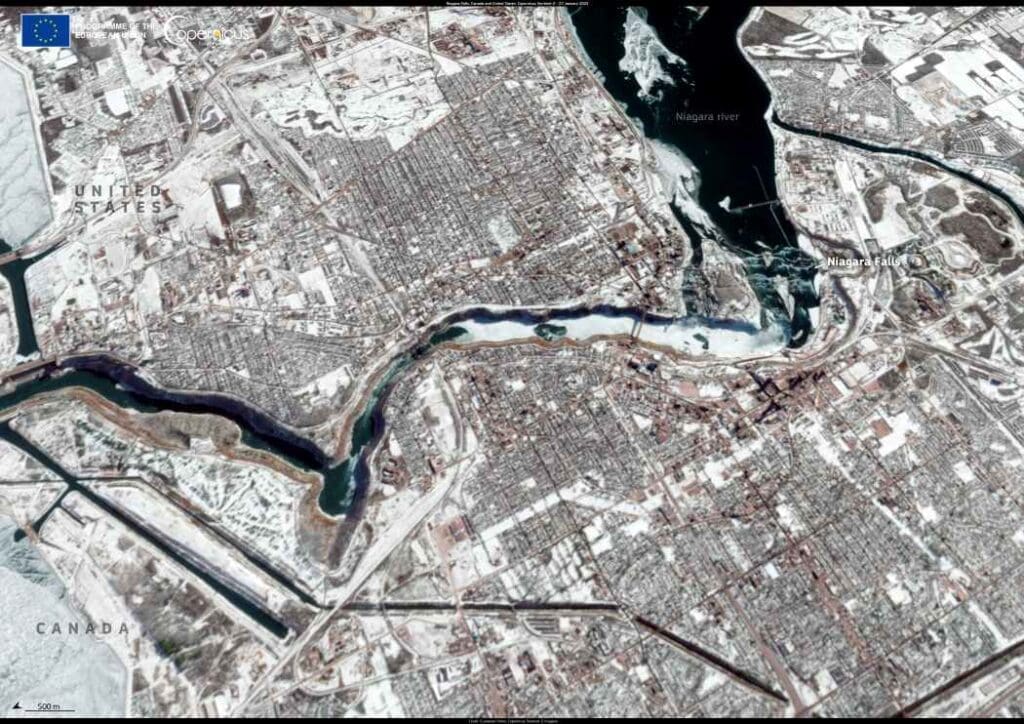A group of European urban areas bordering seas and rivers is paving the way for climate neutrality by 2030.
By Karen McHugh | Horizon, the EU Research and Innovation magazine
In the medieval Belgian city of Bruges, the urban administration has been seeking a new home and decided to move into an old hospital rather than construct a building.
Elsewhere in Bruges, famous for its picture-postcard setting amid winding canals and cobbled streets, work is underway to connect the historic centre with the harbour.
Transition test
The activities shed light on a project that received EU funding to examine ways of accelerating the transition to climate neutrality in nine waterfront cities across Europe. Called Re-Value, it runs for four years through 2026.
The project is drawing inspiration from the New European Bauhaus (NEB) initiative to make everyday living in Europe more sustainable, inclusive and attractive.
‘NEB can be a shortcut to working together faster and better,’ said Koen Timmerman, a policy officer at the City of Bruges. ‘NEB can be an extra gear in our city’s transition to climate neutrality.’
The EU is organising an NEB festival in the Belgian capital Brussels on 9-13 April.
The eight other cities in Re-Value are Ålesund in Norway, Burgas in Bulgaria, Cascais in Portugal, Constanța in Romania, Izmir in Turkey, Písek in the Czech Republic, Rimini in Italy and Rijeka in Croatia.
The project highlights particular challenges – and opportunities – for urban areas that border oceans, seas or rivers. An estimated 40% of people in the EU live in such locations.
On-stage inspiration
‘It’s really about engaging people for climate-neutral cities,’ said Annemie Wyckmans, who leads Re-Value and is a professor of sustainable architecture at the Norwegian University of Science and Technology in Trondheim.
In Ålesund, a theatre group is working with local authorities to spur public debate about tackling environmental threats including biodiversity loss and climate change.
The troupe, Teatret Vårt, has performed an experimental play about what scientists warn is the world’s sixth mass extinction. Unlike the five earlier die-offs, including the most recent one 65 million years ago that killed off dinosaurs, the current mass extinction is driven primarily by human activity including land, water and energy use and pollution.
The theatrical work is called “A Play for the Living in a Time of Extinction” by US dramatist Miranda Rose Hall and serves as the starting point for an audience discussion about topics brought up during the show.
The one-woman play centres on a character who works behind the scenes at a theatre company and is forced to fill in by herself on stage for two absent actors in a performance about the climate crisis. Human interconnectedness and engagement are prime themes.
‘Hopefully the project will give people – both professionals and inhabitants – the confidence to take an active part in developing solutions to create a better life,’ said Wyckmans.
Teatret Vårt has a connection to all nine cities in Re-Value by having performed “A Play for the Living in a Time of Extinction” in each of them.
The shows have prompted audience members to talk and think about the future and what they can do to help shape it, according to Wyckmans.
‘We do this exercise with people: if you close your eyes and you imagine, what would 2030 look like?’ she said. ‘If you just think of your own neighbourhood, what do you do? How do you live? What about your family and friends? What does it smell like in terms of air quality?’
Lake of Love
In Bruges, action is accompanying the talking and thinking.
The city administration will move into a sprawling red-brick structure that was built in a neo-Gothic style in the late 19th century and once served as a hospice for vulnerable and incurably ill women before becoming a retirement home.
The building, which runs the length of a whole street block, is named after the nearby Lake of Love – Huize Minnewater in Flemish. The move may take place in 2027 after a renovation that is still being prepared.
‘The renovation should not only be sustainable and beautiful – it should at the same time be an inspiring and motivating place where we can build together our Bruges of tomorrow,’ said Timmerman.
The planned connection between the city centre and the harbour is a joint collaboration among local authorities, cultural organisations, craft makers and food producers.
It involves regenerating the Quay District in line with NEB principles. That means making optimum use of space by all actors and encouraging sustainable activities.
Urban forest
Much farther south, on the Adriatic coast, Rimini is using nature-based solutions to climate stress by creating two parks: the seafront Parco del Mare and the riverfront Parco Marecchia. The goal is to renaturalise a heavily urbanised land.
On the seafront, the city has removed a road to create a green area for pedestrians with a wide array of plants and trees. The vegetation includes the Lippia nodiflora plant that needs relatively little water and trees such as stone pine and evergreen oak that are salt-tolerant. The layout of the trees maximises shade and the park acts as a barrier against coastal flooding.
In part of the seafront park, which is due to be completed in June this year, the city is building a sustainable stormwater-drainage system. Rather than being piped into a sewer network, the park’s drainage system will feed into the ground below through the use of permeable materials, avoiding sewage overflows into the sea.
Separately in Rimini, a local volunteer group asked and received permission from the municipality to convert an area around an old hotel into a garden and playground.
‘We created Re-Value exactly to be able to support these kinds of initiatives,’ said Wyckmans. ‘It was so inspiring.’
Coastal communities
Another EU-funded project is working with communities in coastal cities to develop NEB-inspired moves towards climate neutrality.
Called Bauhaus of the Seas Sails, or BoSS, the three-year project runs until the end of 2025.
It focuses on different coastal ecosystems in six EU countries: Belgium, Germany, Italy, the Netherlands, Portugal and Sweden.
The lessons learned will help inform other cities across Europe in a bid to inspire them to reproduce the most successful initiatives.
‘Our goal is to bring the principles of the New European Bauhaus – beautiful, sustainable, together – to our coastal cities,’ said Nuno Jardim Nunes, a professor of human-computer interaction at the Technical University of Lisbon in Portugal and coordinator of BoSS.
Lisbon lessons
In Lisbon, the project’s attention is on food and sustainability.
The researchers are working with city residents, chefs and schools to design menus that integrate materials and resources from the Tagus estuary to make diets more local and sustainable.
‘We need to urgently connect the policies of sustainability and ocean preservation to ensure we don’t endanger these very fragile areas,’ said Jardim Nunes.
The project is also looking in Lisbon at river and ocean materials such as algae, shells and flotsam that could be used for furniture or construction materials.
The emphasis is on small-scale initiatives to see whether they could be scaled up eventually to build structures like houses.
Jardim Nunes, who was raised on the Madeira Islands and inspired by the sea from an early age, said that different generations and cultures need to work together to address the climate crisis.
Elsewhere in the project, Malmö in Sweden is converting former docks into a sustainable living and working district, Venice in Italy is seeking to reconnect senior citizens to its lagoon and Hamburg in northern Germany is promoting education about the sea.
‘To bring about change, we need to inspire people and give them hope,’ said Jardim Nunes. ‘BoSS is trying to achieve practical, small examples of how this could work at scale.’
Research in this article was funded by the EU’s Horizon Programme. The views of the interviewees don’t necessarily reflect those of the European Commission. If you liked this article, please consider sharing it on social media.
NEW EUROPEAN BAUHAUS
A century after it emerged in Germany, the Bauhaus school of art, architecture and design is getting a rebirth in Europe in a bid to improve urban life. The New European Bauhaus (NEB) aims to help cities across the EU become less polluting and more attractive through artistic, cultural and technological projects reaching many millions of residents. Initiated by the European Commission in 2020, the NEB has three prime goals: reduce environmental harm including climate change, tackle social inequalities such as exclusion and spruce up public areas. Changing the design and use of urban spaces and structures is central to the whole undertaking, with sustainability, inclusion and aesthetics shaping the overall vision. While serving policy goals set at EU level, the NEB relies on bottom-up initiatives undertaken by a range of people and organisations. These include city dwellers, artistic groups, architectural experts and local businesses, authorities and students. Research is a main feature of the NEB, with almost €160 million for EU projects in 2021-2024.
Watch the video:
This article was originally published in Horizon, the EU Research and Innovation magazine, by Karen McHugh. Republished by Muser Press under the Creative Commons Attribution 4.0 International licence.
More information:
Re-Value, BoSS, New European Bauhaus, EU Mission: Climate-Neutral and Smart Cities;
Featured image credits: wirestock | Freepik.com




